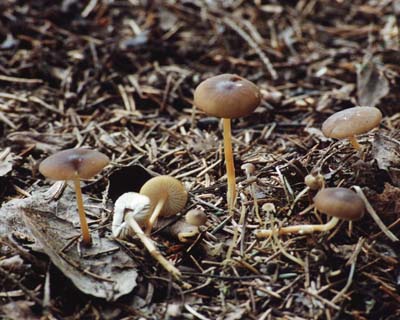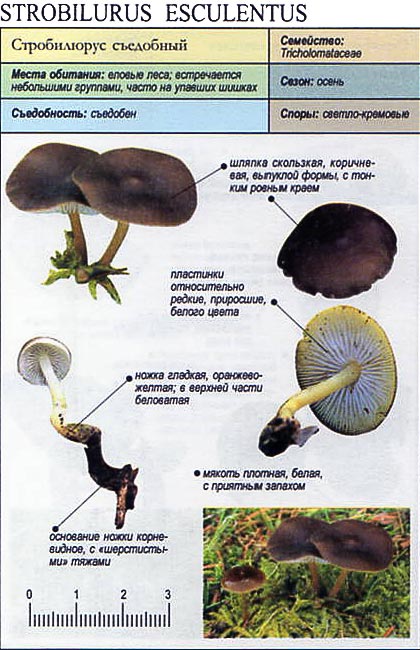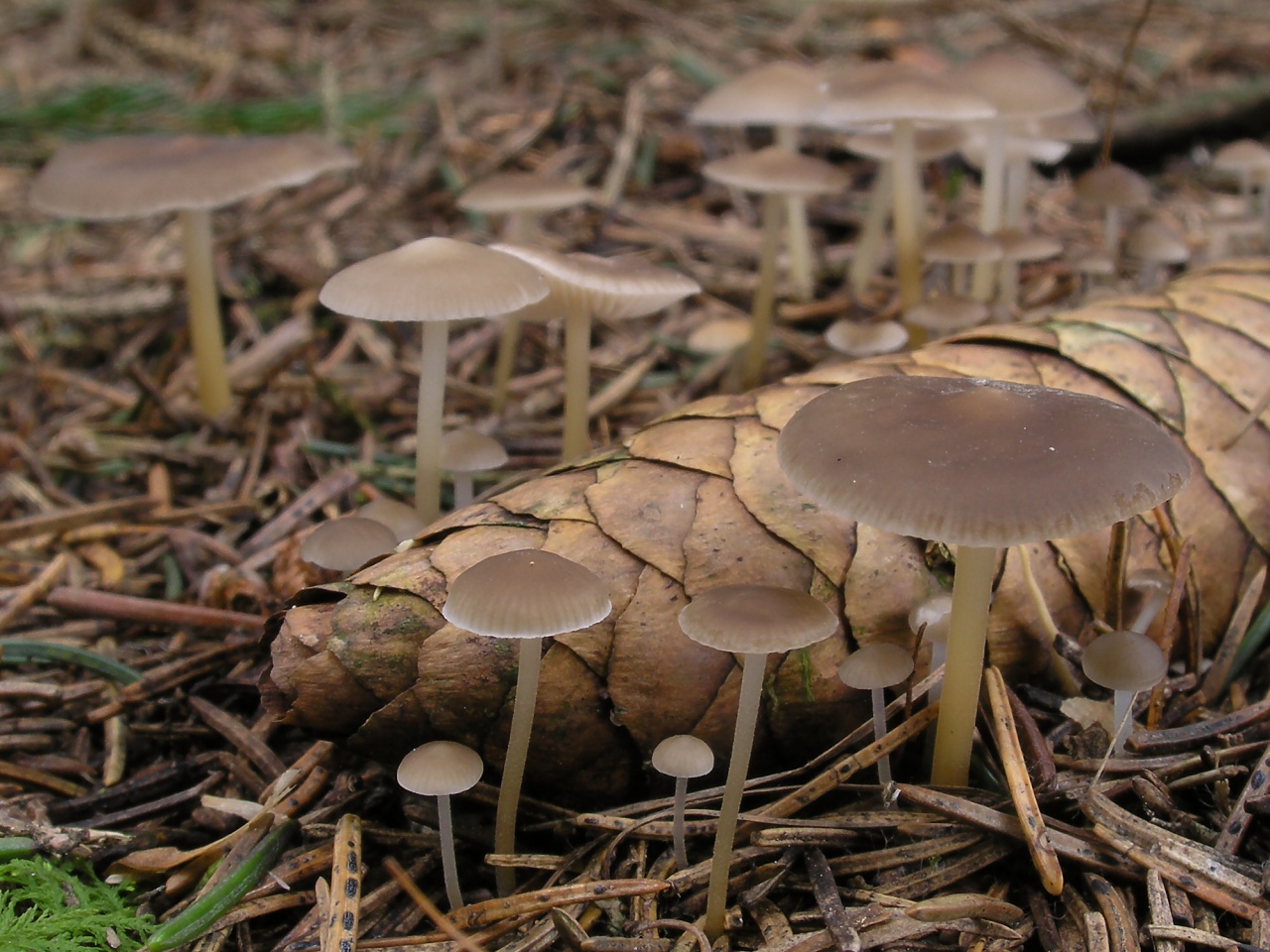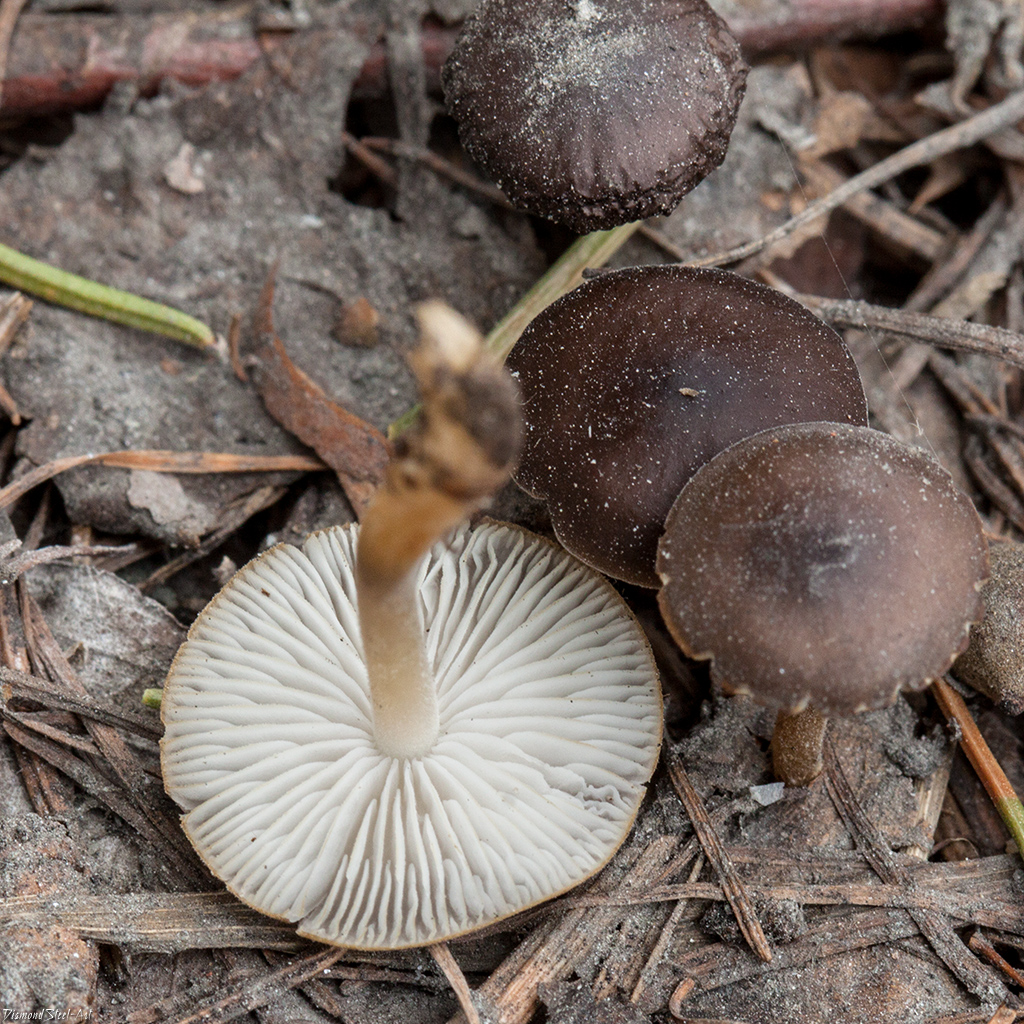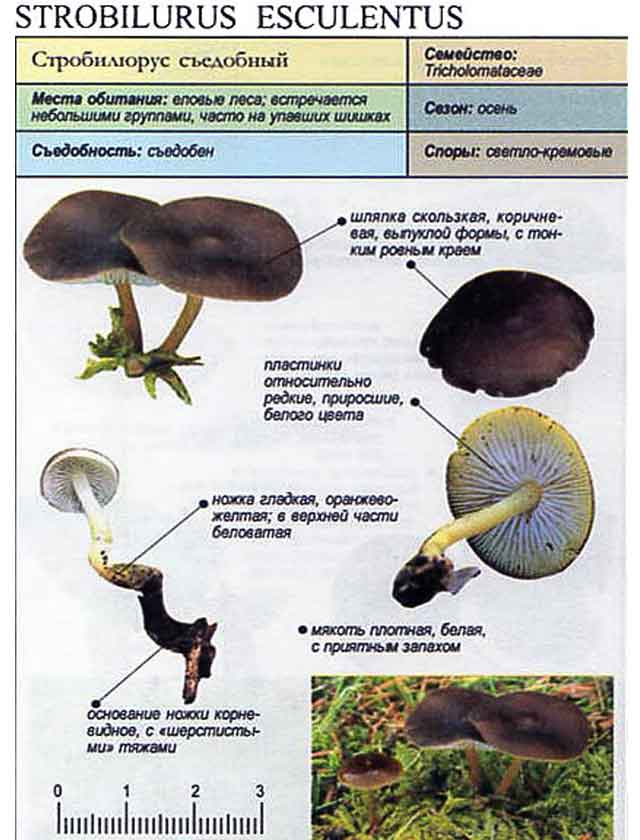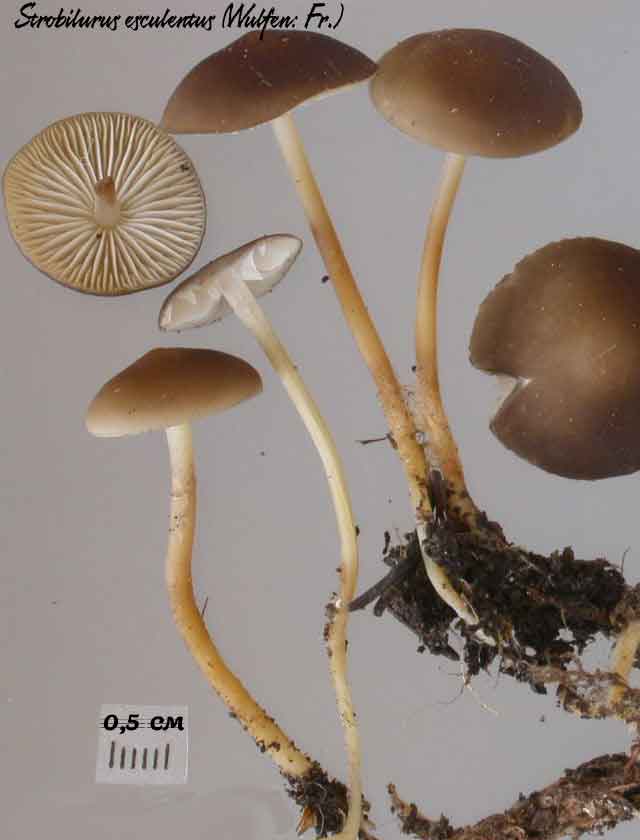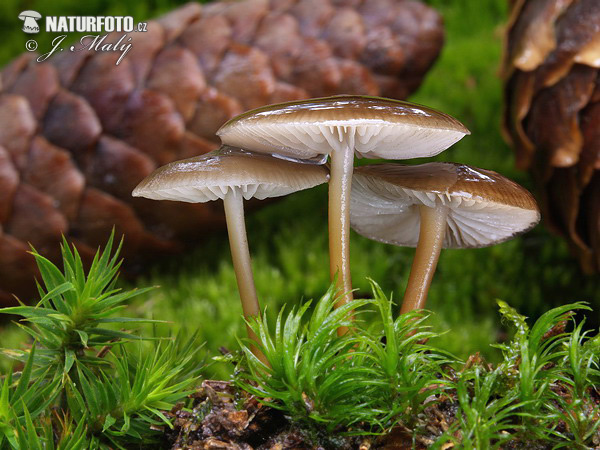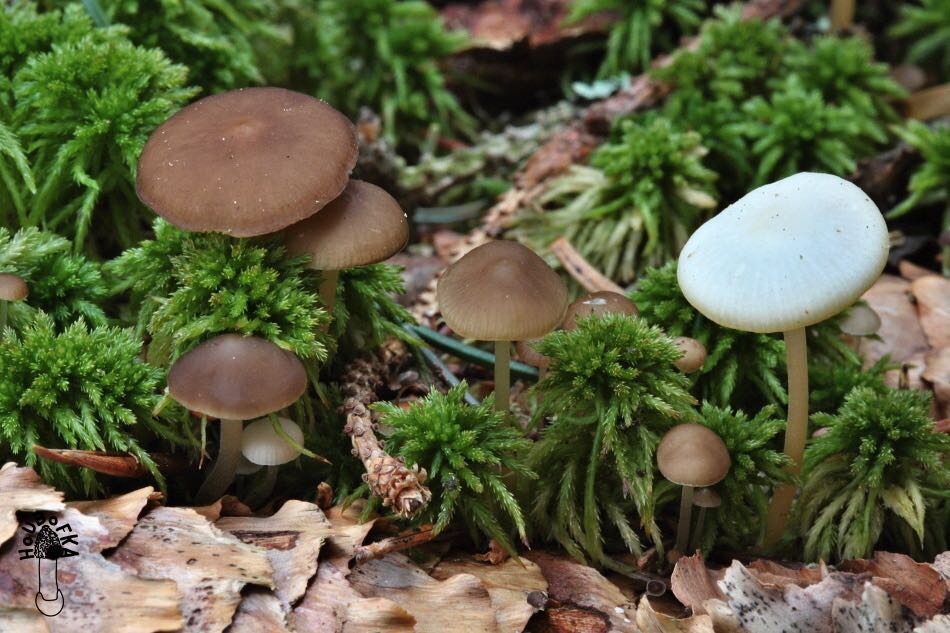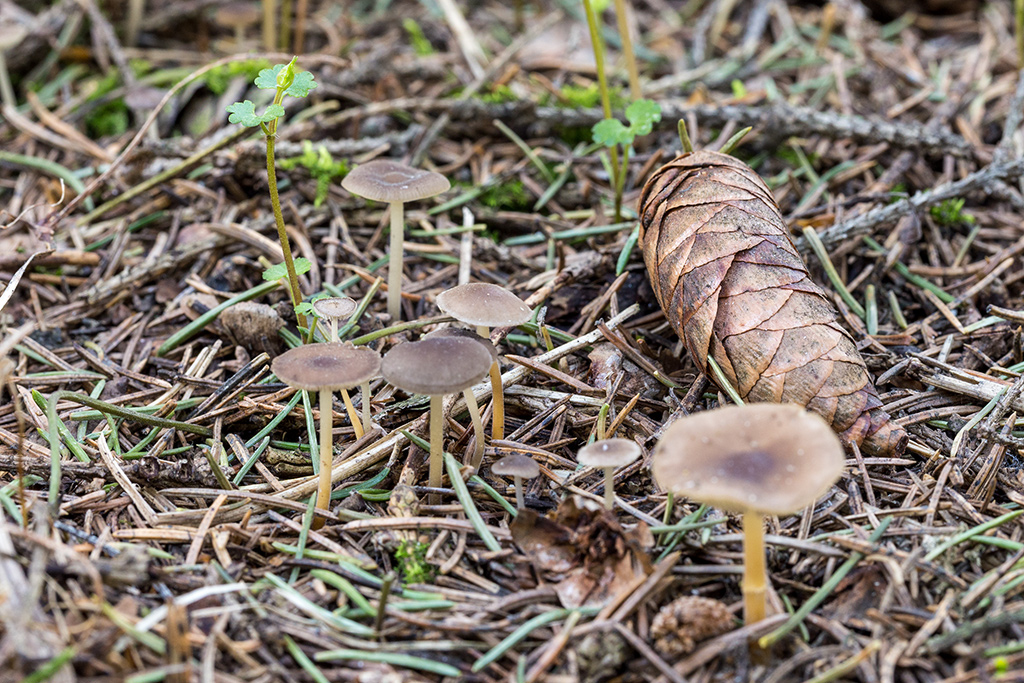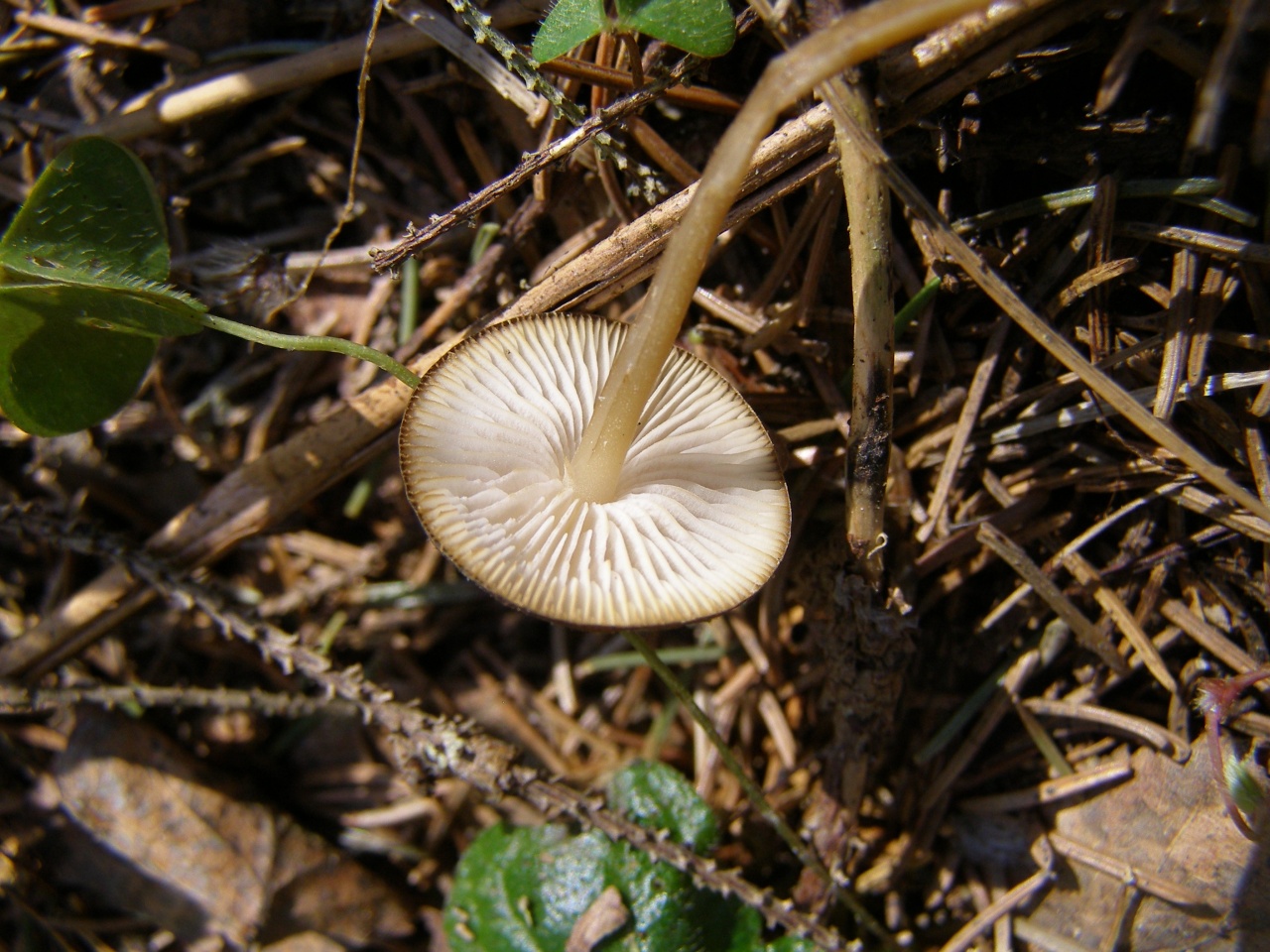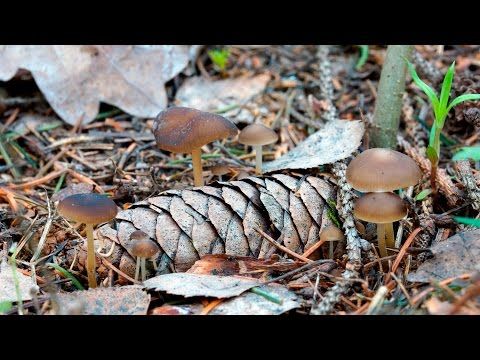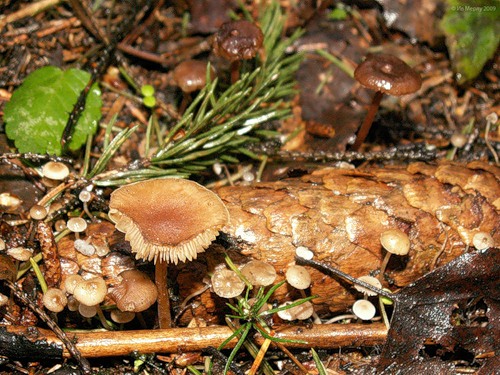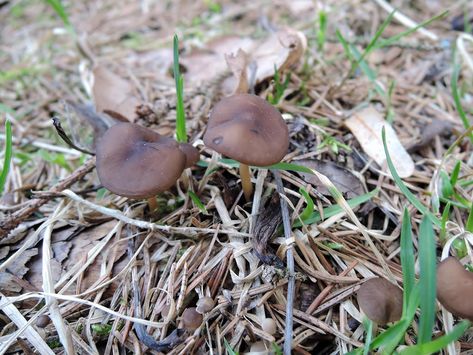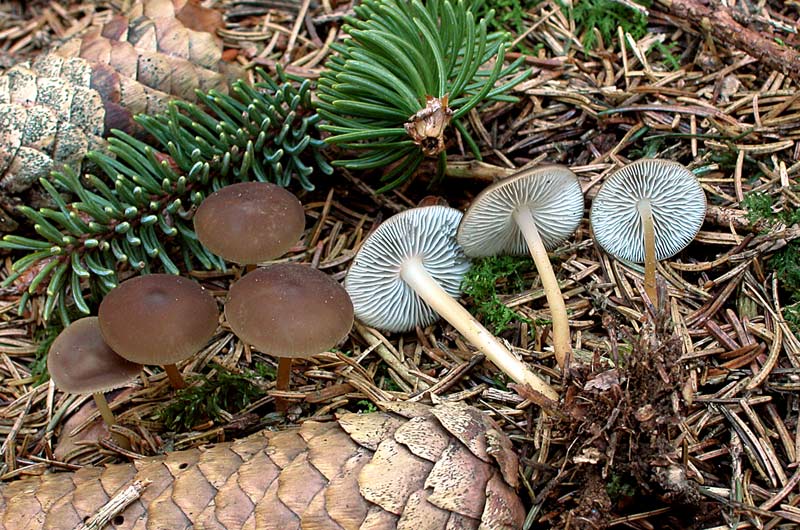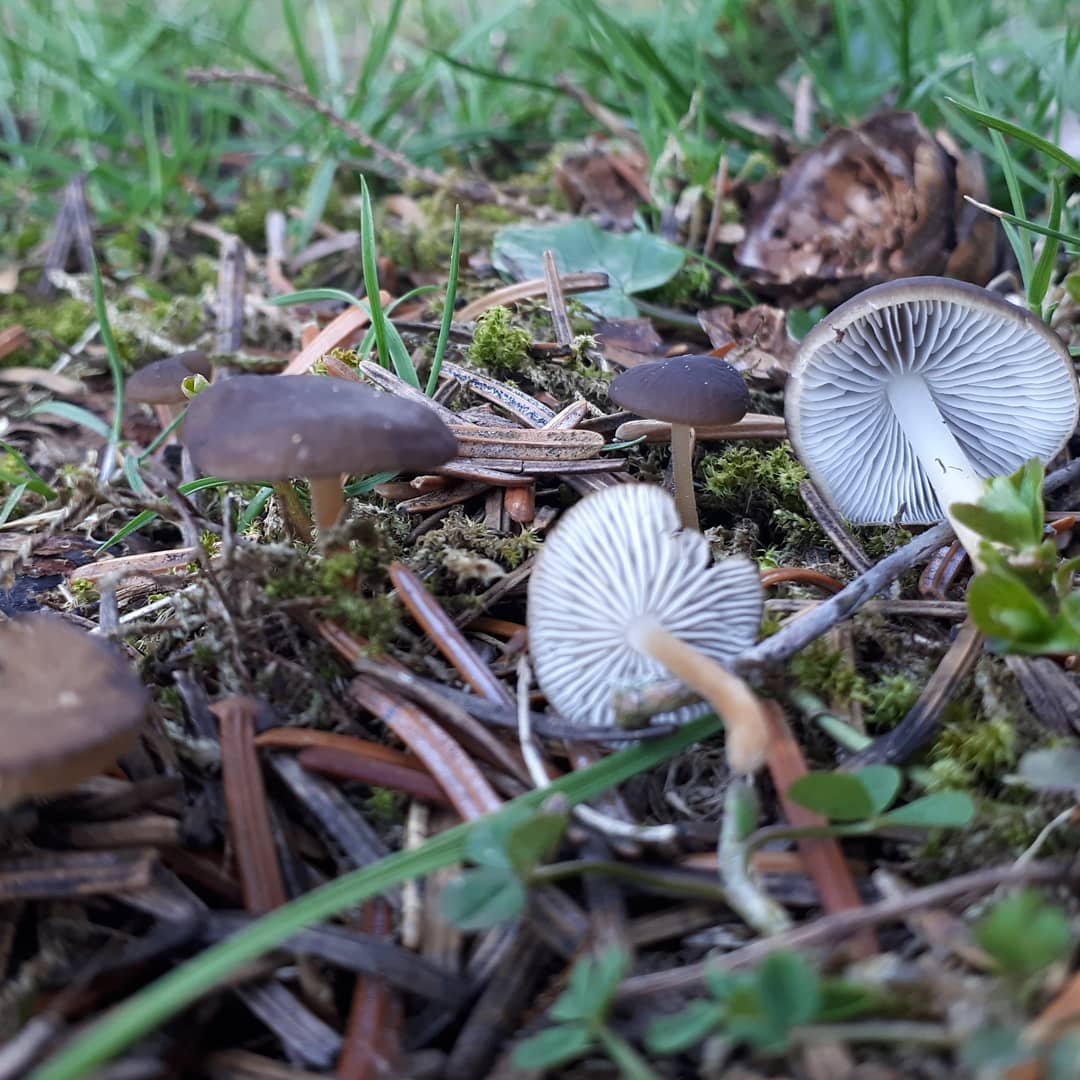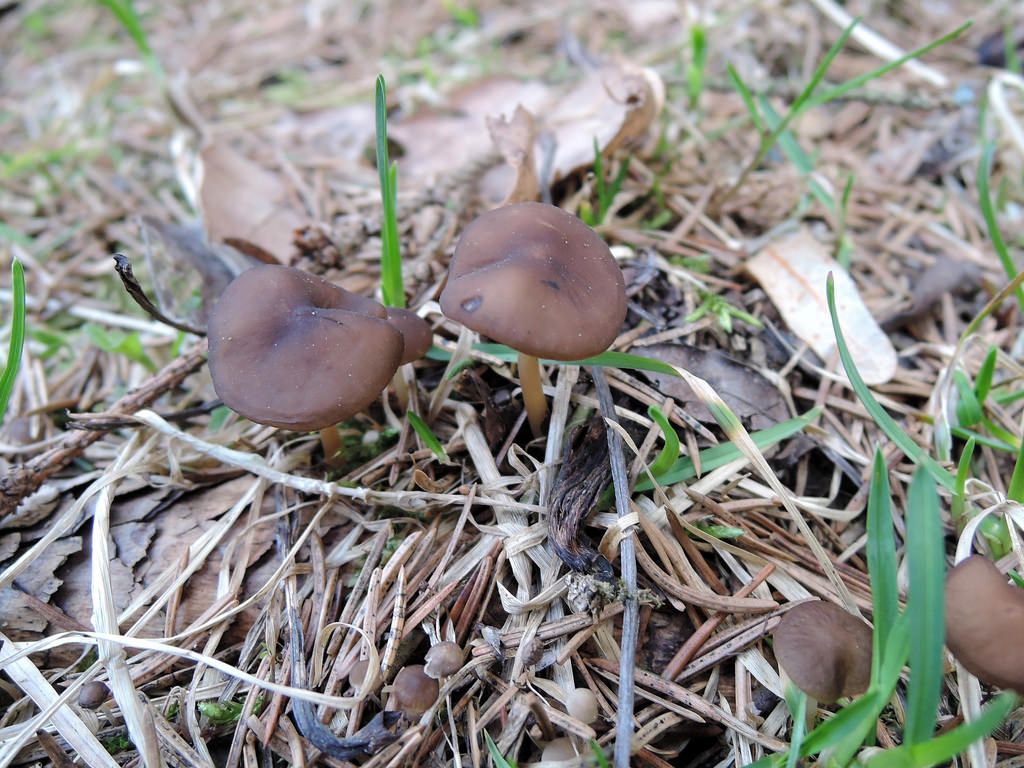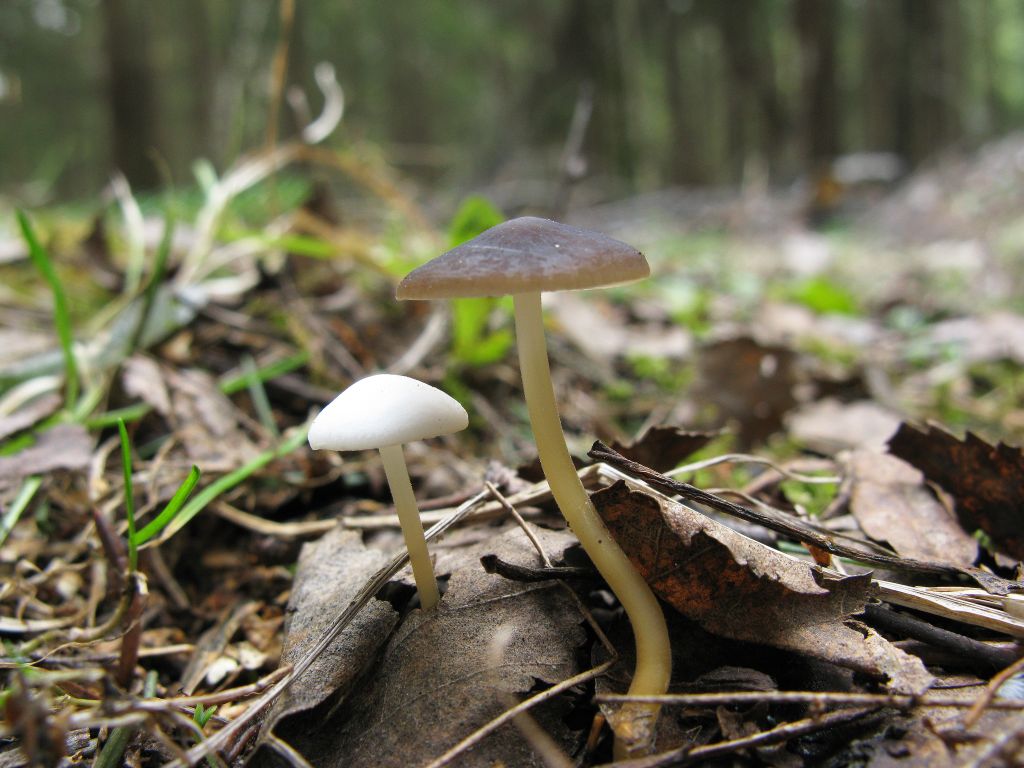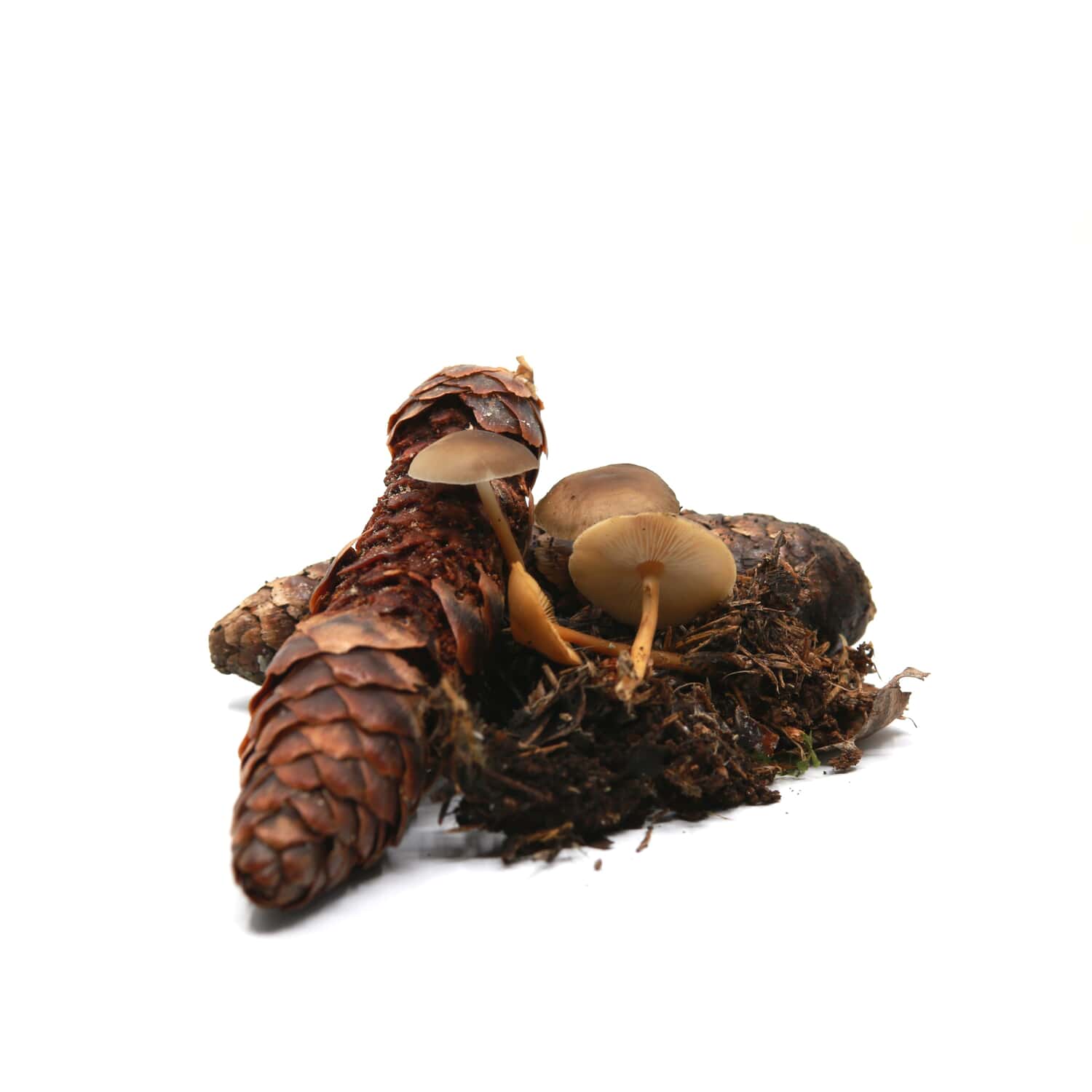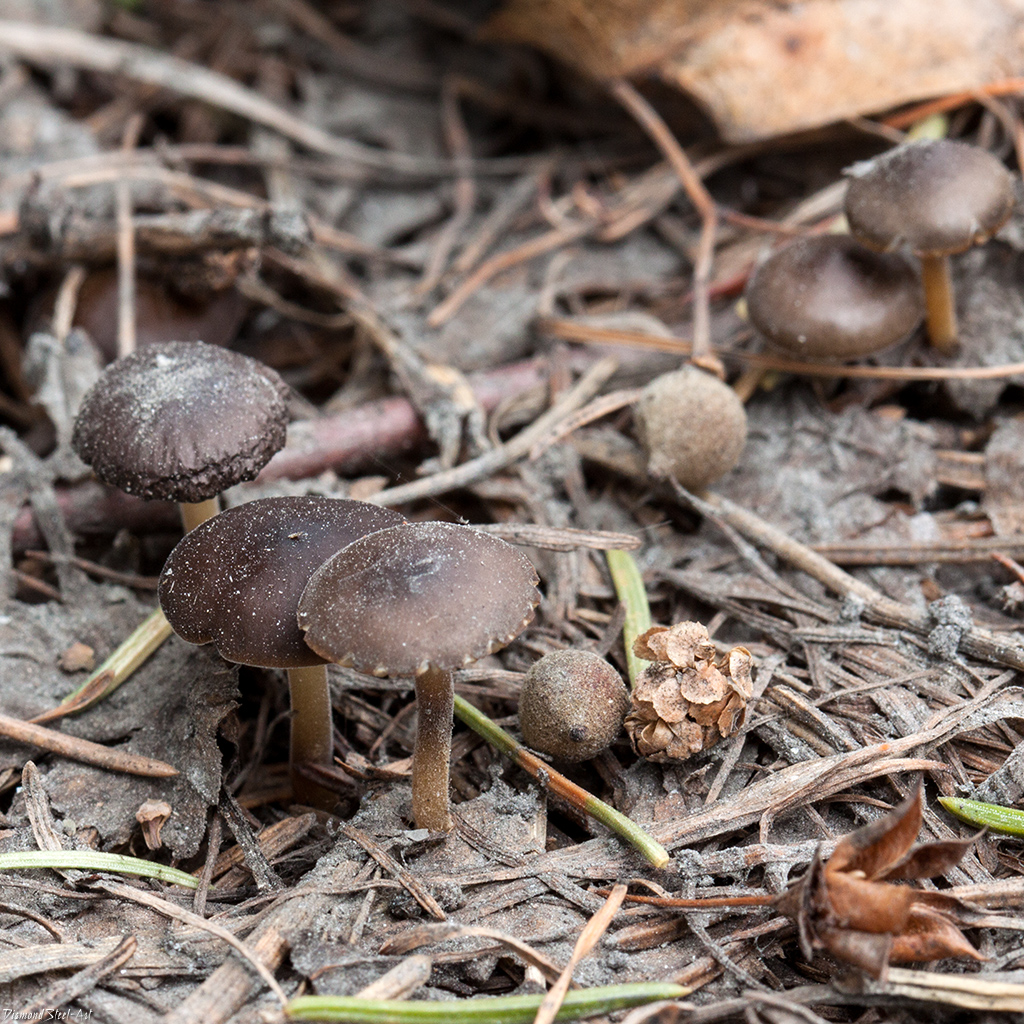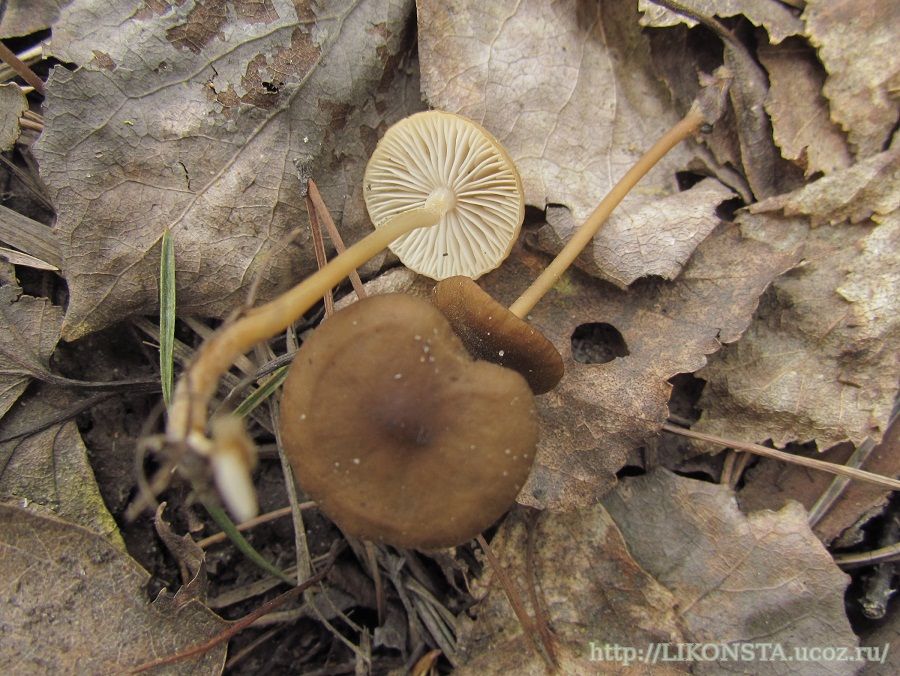Cutting strobilurus (Strobilurus tenacellus)
Synonyms:
- Strobilurus bitter
- Pineapple lover tenacious
- Collybia tenacellus
Hat:
in a young mushroom, the cap is hemispherical, then it opens and becomes practically open. At the same time, the central tubercle remains, which is generally not very pronounced. The surface of the cap is brown, often with a characteristic reddish-reddish tint in the center. The diameter of the cap is up to two centimeters. The cap is very thin and brittle. The edges of the cap are smooth or pubescent, also thin. According to some observations, the color of the cap varies greatly from whitish to brown, depending on the growing conditions of the fungus: the illumination of the place, the ground, and so on.
Pulp:
thin, but not brittle, white. In adult mushrooms, plates shine through the edges of the cap. The pulp has a pleasant mushroom aroma, but it tastes bitter.
Plates:
loose, not frequent, white or yellowish.
Spore Powder:
White.
Leg:
the leg is very long, but most of it is usually hidden in the ground. The leg is hollow inside. The surface of the leg is smooth. The upper part of the leg has a whitish color, the lower part has a characteristic brownish-red color. The height of the leg is up to 8 centimeters, the thickness is no more than two millimeters. The stem is thin, cylindrical, matte, cartilaginous. The leg has a long, shaggy or pubescent tapered base, with which the mushroom is attached to a pine cone buried in the ground. Despite its thinness, the leg is very strong, it is almost impossible to break it with your hands. The pulp of the leg is fibrous.
Spreading:
Strobilurus is found in pine forests. Fruiting time from mid-April to mid-May. Sometimes you can find this mushroom in late autumn, depending on the characteristics of the growing conditions. Grows on fallen cones near pine trees. Grows in groups or singly. A fairly common view.
Similarity:
Cutting strobilurus resembles the twine-legged Strobilius, which also grows on pine cones, but differs in the smaller size of the fruiting body and the lighter shade of the cap. It can also be mistaken for a Juicy Strobilurus, but it grows exclusively on fir cones, and its leg is much shorter and there is a pronounced tubercle in the center of the cap.
Edibility:
Young mushrooms are quite good for eating, but here are their sizes. Is it worth fooling around and collecting such a trifle. But, in the spring forest, there is often to collect, then there is nothing more, therefore, as an option, you can try and Strobilurus cuttings.
Remarks: despite the almost complete similarity, the cuttings Strobilurus is still not as attractive as the closely related species S. Esculentus. The smell is pleasant enough, but not strong, the taste is bright, but not memorable. But, at the same time, it is much more pleasant to collect these tiny mushrooms growing on cones in a pine forest than to wade through a groin spruce forest.
Edible strobilurus, Strobilurus esculentus
Hat: Diameter 1-3 cm, hemispherical in youth, then prostrate. In the center, as a rule, there is a characteristic darkish tubercle. The edges are wavy, the plates are translucent. Color - cream, from light, whitish to almost brown. From moisture it becomes dark, shiny. The pulp is thin, with an intense and very pleasant scent.
Hymenophore: The plates are loose, frequent, rather wide, whitish (not pure white), often with darker spaces.
Spore powder: White.
Leg: Thin, 2-3 cm in height, hollow, lighter on top, below - the color of the cap (various shades are possible). The flesh of the leg is creamy.
Spreading: It occurs from mid-April to late autumn, although the main fruiting peak occurs in the spring. It grows on spruce cones buried in coniferous litter.
Similar species: On pine cones, the twine-footed strobilurus (Strobilurus stephanocystis), as well as the cutting strobilius (Strobilurus tenacellus>), grow. They are indistinguishable from each other.
Edibility: The mushroom is edible and has a great aroma, but its size does not allow us to consider Strobilurus as a food product.
Author's notes: It was at the very beginning of my mushroom career. Having already heard a lot about spring pineapple lovers, I was in the mood for easy success. It was not there. In the middle and end of April, I climbed all the Moscow forest parks, carefully looking for “little brown hats” under belated snow and vaguely feeling that I was somehow deceived. There were none! On May, I went to the village, where I gloomily plowed through the spruce forests. There was nothing in the first spruce forest. In the second - nothing too. It seemed that there was nothing in the third, when suddenly. In short, I found it. Found it all the same. In a single place, under a single spruce - mixed with alkaline mycena (Mycena strobilicola). Neither strobiluri nor mycenae were found anywhere else. Such is the mushroom forest.
It should also be noted that it is not for nothing that in some places this Strobilurus is called not edible, but juicy. The point, of course, is not that he has some kind of juice - it's about the smell. And he has such a smell that you rock. You will download in an amicable way. Good smell, delicious, mushroom.
Delicate spring mushrooms somehow do not tolerate the first heat of May very well: they dry out very quickly, wrinkle and lose all aesthetic appeal. However, Strobilurus esculentus is a swift mushroom: as soon as coolness sets in, it returns to its favorite buds.
The late and bustling spring of 2012 was to their liking. In the spruce forest I did not want to walk at all - it was very strange to walk over live mushrooms.
The roots of the edible strobilirus go deep into the bump. And if you take into account that the cones themselves are quite deeply immersed in the litter, it turns out that it is perfectly visible in the picture. Most of the mushroom is hidden from prying eyes; only a neat “carnation” sticks out on the surface.
Edible strobilus is easy to identify: it is enough to see a spruce cone nearby (which is not difficult) and to smell the mushroom from the accompanying mycens. By the way, it is curious that in our area (from where, in fact, the photographic cone), alkaline mycenes first grow, then edible strobiluriuses, and only then, in late autumn, mouse-tailed beospores (Baeospora myosura). And the woodpecker who trained the cones for this whole feast was recently spotted at the telegraph pole. In short, each has his own hobby.
I really wanted to make sure that this glorious mushroom really originates from a cone, but I spoiled one immediately, without getting to the bottom of any cones, and I felt sorry for the rest: there were not so many of them, but all that were gathered around a single Christmas tree ...
Definitioner
- Basidia (Basidia)
-
Lat. Basidia. A specialized structure of sexual reproduction in fungi, inherent only in Basidiomycetes. Basidia are terminal (end) elements of hyphae of various shapes and sizes, on which spores develop exogenously (outside).
Basidia are diverse in structure and method of attachment to hyphae.
According to the position relative to the axis of the hypha, to which they are attached, three types of basidia are distinguished:
Apical basidia are formed from the terminal cell of the hypha and are located parallel to its axis.
Pleurobasidia are formed from lateral processes and are located perpendicular to the axis of the hypha, which continues to grow and can form new processes with basidia.
Subasidia are formed from a lateral process, turned perpendicular to the axis of the hypha, which, after the formation of one basidium, stops its growth.
Based on morphology:
Holobasidia - unicellular basidia, not divided by septa (see Fig. A, D.).
Phragmobasidia are divided by transverse or vertical septa, usually into four cells (see Fig. B, C).
By type of development:
Heterobasidia consists of two parts - hypobasidia and epibasidia developing from it, with or without partitions (see Fig. C, B) (see Fig. D).
Homobasidia is not divided into hypo- and epibasidia and in all cases is considered holobasidia (Fig. A).
Basidia is the place of karyogamy, meiosis and the formation of basidiospores. Homobasidia, as a rule, is not functionally divided, and meiosis follows karyogamy in it. However, basidia can be divided into probasidia - the site of karyogamy and metabasidia - the site of meiosis. Probasidium is often a dormant spore, for example in rust fungi. In such cases, probazidia grows with metabasidia, in which meiosis occurs and on which basidiospores are formed (see Fig. E).

See Karyogamy, Meiosis, Gifa.
- Pileipellis
-
Lat. Pileipellis, skin - differentiated surface layer of the cap of agaricoid basidiomycetes. The structure of the skin in most cases differs from the inner flesh of the cap and may have a different structure. The structural features of pileipellis are often used as diagnostic features in descriptions of fungi species.
According to their structure, they are divided into four main types: cutis, trichoderma, hymeniderma and epithelium.
See Agaricoid fungi, Basidiomycete, Cutis, Trichoderma, Gimeniderm, Epithelium.


